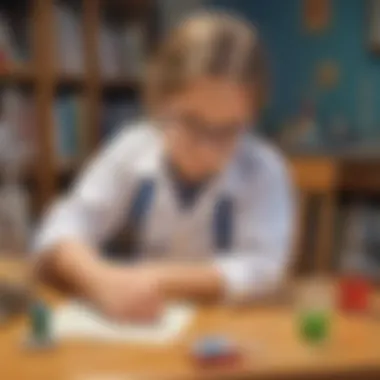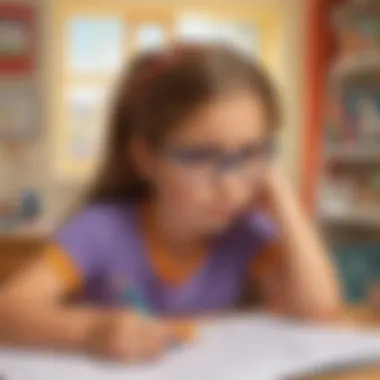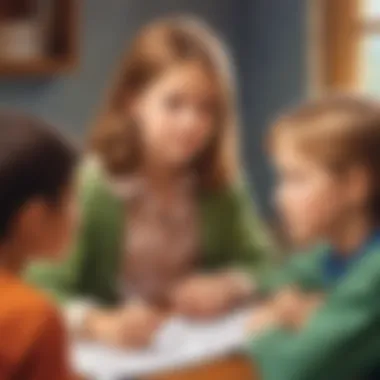Unlocking the Educational Potential of 2nd Graders: A Comprehensive Guide


Creative Activities
In the developmental journey of a 2nd grader, engaging in creative activities holds immense importance. Not only do these activities foster imagination and creativity, but they also enhance essential skills such as hand-eye coordination and problem-solving. Craft Ideas: Encouraging children to partake in creative crafts like origami, DIY cards, and simple painting projects can ignite their artistic flair and boost their confidence in creating. Step-by-Step Guides: Providing detailed step-by-step instructions for each activity ensures that children can follow along easily and successfully complete their artistic endeavors. Educational Value: These creative activities contribute to the holistic development of children by nurturing their cognitive abilities, fine motor skills, and capacity for self-expression.
Fun Quizzes
Integrating fun quizzes into a 2nd grader's learning journey infuses an element of enjoyment into educational pursuits. Quiz Topics: Covering a wide range of subjects from math and science to language arts, quizzes available on platforms like ElemFun cater to diverse interests and knowledge domains. Question Types: By incorporating multiple-choice, true or false, and fill-in-the-blank questions, these quizzes engage children by varying the cognitive challenges they present. Knowledge Reinforcement: Quizzes serve as valuable tools for reinforcing learning concepts, helping children retain information, and apply it effectively in different contexts, thereby solidifying their understanding and retention of key academic principles.
Fact-Based Articles
Offering access to fact-based articles enriches a 2nd grader's learning experience by providing them with credible information on a myriad of topics. Topics: Fact-based articles cover a broad spectrum of subjects ranging from history and nature to current events and fascinating trivia, catering to the diverse curiosity of young minds. Engaging Content: These articles present complex information in a simplified, engaging manner that is easy for children to comprehend, sparking their interest and encouraging them to delve deeper into the world of knowledge. Additional Resources: By including links to related articles and external resources, children can explore further on topics they find intriguing, expanding their learning horizons and nurturing a love for continuous discovery and learning.
Language Arts
As you delve into the realm of Language Arts in this article focusing on educational expectations for 2nd graders, you uncover a foundational skill set crucial for academic and intellectual growth. Language Arts encapsulates various elements such as reading, writing, and spelling, each playing a vital role in a child's educational journey. By mastering Language Arts, students cultivate proficiency in communication, critical thinking, and expression, essential skills for lifelong learning and success at school.
Reading
Fluency
When it comes to Fluency, the ability to read with speed, accuracy, and expression, factors significantly in a child's reading development. Fluency enhances comprehension and fluency casts,contributes im measuredetrics tot the overall reading experience, enabling children to engage deeply with texts and derive meaning more efficiently. Moreover, Fluency boostsa child's phonemic awareness and strengthens their decoding skills, thus fostering independent reading with ease and enjoyment.
Comprehension
In the realm of Comprehension, the capacity to understand and interpret texts is paramount. Comprehension ensures that students grasp the meaning of what they read, fostering critical thinking and analytical skills. By comprehensively engaging with texts, children hone their ability to draw inferences, make connections, and evaluate information, thereby deepening their understanding of diverse subject matters and broadening their intellectual horizons.
Vocabulary Expansion
Vocabulary Expansion stands as a cornerstone in nurturing lexical diversity and language proficiency in young learners. By delving into new words, expressions, and meanings, children not only enhance their communication skills but also enrich their cognitive abilities. Vocabulary Expansion equips students with the lexicon needed to articulate their thoughts effectively, comprehend complex texts, and express themselves with precision, empowering them to communicate fluently and confidently.
Writing
Within the domain of Writing, students embark on a journey to harness their language skills, creativity, and self-expression. Grammar serves as the backbone of effective communication, laying the groundwork for clear and coherent writing. Proper Punctuation enhances the readability and coherence of written work, ensuring that ideas are conveyed with accuracy and clarity. Moreover, Creative Writing nurtures imagination and originality, allowing students to explore different genres, styles, and narratives, fostering a love for writing and storytelling.
Spelling
Common Sight Words
Common Sight Words form the building blocks of literacy, encompassing frequently used words crucial for fluency and comprehension. By mastering these words, children enhance their reading speed and accuracy, facilitating a seamless reading experience. Embracing Common Sight Words equips students with the vocabulary foundation necessary to tackle more complex texts and comprehend diverse subject matters with ease.
Spelling Rules


Navigating the intricacies of Spelling Rules empowers students with the tools to spell words correctly and consistently. Understanding rules governing phonics, syllables, and morphology aids children in deciphering unfamiliar words and applying spelling patterns effectively. By internalizing Spelling Rules, students develop spelling proficiency, improve their written communication, and cultivate attention to detail in their written work.
Word Patterns
Exploring Word Patterns introduces young learners to the systematic arrangement of letters and sounds in words, exposing them to recurring structures and phonetic relationships. By identifying and analyzing these patterns, children sharpen their spelling skills, enhance their phonetic awareness, and expand their vocabulary repertoire. Word Patterns offer a strategic approach to spelling and decoding words, empowering students to tackle unfamiliar words confidently and develop a deeper understanding of language mechanics.
Mathematics
Mathematics is an indispensable subject in the educational journey of a 2nd grader. It serves as the foundational framework for developing critical thinking skills, problem-solving abilities, and analytical reasoning. Understanding mathematics at this level lays the groundwork for advanced concepts in later grades, making it an essential component of the curriculum for young learners.
Basic Operations
Addition
Addition is a fundamental arithmetic operation that involves combining two or more numbers to find their total sum. This process teaches children how to add quantities and understand basic numerical relationships. With addition, students enhance their mental math skills, improve calculation speed, and grasp the concept of counting and combining quantities effectively. It is a crucial skill that forms the basis for more complex mathematical operations in the future.
Subtraction
Subtraction is the inverse operation of addition, where numbers are subtracted to find the difference between them. This concept introduces the idea of taking away or finding the missing quantity, promoting problem-solving abilities and logical reasoning. Through subtraction, students learn to compare quantities, understand relationships between numbers, and develop a deeper sense of numerical fluency.
Multiplication
Multiplication involves repeated addition and helps in understanding the concept of equal groups and arrays. This operation encourages students to build a strong conceptual understanding of multiplication as scaling and repeated addition. By mastering multiplication, children develop efficient strategies for solving mathematical problems, strengthen their number sense, and enhance their overall mathematical fluency.
Division
Division is the process of sharing or grouping a number into equal parts. It teaches students the concept of distribution and partitioning quantities into equitable portions. Through division, children learn the relationship between multiplication and division, enhance their problem-solving skills, and grasp the significance of fair sharing and equal distribution. Mastering division is crucial for building a solid foundation in mathematical literacy and problem-solving.
Science
Science plays a pivotal role in shaping a 2nd grader's academic and intellectual development. It serves as a foundation for critical thinking, problem-solving, and fostering curiosity about the world. By exploring various scientific concepts, children hone their observation skills, learn to make predictions based on evidence, and develop a deeper understanding of the natural phenomena around them. Science also encourages experimentation, which helps students grasp abstract ideas through hands-on experiences and engages them in the process of inquiry and discovery.
Life Science
Plants
Within the realm of Life Science, the study of plants holds significant importance for young learners. Understanding plants contributes to children's awareness of the environment, ecosystems, and the process of photosynthesis. Plants showcase a unique characteristic of converting sunlight into energy, making them vital for sustaining life on Earth. Exploring the anatomy of plants and their growth patterns allows students to appreciate the interconnectedness of living organisms and their surroundings. However, some challenges arise in teaching about plants, such as the complexity of botanical terminology or the limited availability of hands-on plant-related activities for practical learning.
Animals
The exploration of animals in Life Science offers valuable insights into biodiversity, habitats, and adaptation. Studying animals enables children to comprehend the diversity of species, animal behaviors, and interdependence in nature's ecosystem. Animals exhibit fascinating characteristics, from camouflaging abilities to unique mating rituals, captivating young minds and nurturing a sense of wonder about the natural world. However, challenges may arise in teaching about animals due to the ethical considerations of animal captivity, the balance between education and entertainment, or the accessibility of up-to-date resources on different animal species.
Life Cycles


Delving into life cycles provides a comprehensive view of organisms' growth and development stages. Studying life cycles aids children in understanding natural processes such as metamorphosis, reproduction, and the circle of life. Observing life cycles instills a sense of responsibility towards living creatures and fosters an appreciation for the natural progression of life. However, teaching life cycles may present challenges like the visualization of abstract concepts, finding varied examples to illustrate different life cycles, and ensuring age-appropriate content that aligns with scientific accuracy.
Physical Science
Forces and Motion
In the realm of Physical Science, the exploration of forces and motion uncovers the principles governing interactions in the physical world. Understanding forces like gravity, friction, and magnetism elucidates how objects move and behave. Investigating motion instills core physics concepts, such as inertia and acceleration, in young scholars, laying the groundwork for comprehension of more complex scientific phenomena. However, elucidating forces and motion to elementary students can be challenging due to the abstract nature of these concepts, requiring innovative teaching methods that bridge theory with real-life examples.
Matter
Scrutinizing matter introduces 2nd graders to the fundamental building blocks of the universe. Learning about different states of matter, chemical properties, and changes in physical substances underscores the importance of matter in everyday life. Matter surrounds us in various forms, from liquids to gases, shaping our interactions with the world. Engaging with matter experiments and observations enables students to grasp scientific principles experientially, although challenges may arise in conveying abstract theories about matter interaction and transformations.
Energy
Exploring energy unveils the transformations and transfers of power vital for sustaining natural processes. Observing energy sources, conversions, and the significance of energy conservation instills an awareness of energy's role in everyday activities. Recognizing various forms of energy, such as light, heat, and kinetic energy, empowers children to understand the interconnectedness of energy in the world's functioning. However, teaching energy concepts to young learners may pose challenges related to the abstract nature of energy, the need for simplified explanations, and promoting sustainable energy practices through engaging educational experiences.
Earth Science
Weather
The study of weather elucidates atmospheric phenomena, seasonal changes, and climatic patterns worldwide. Understanding weather patterns, cloud formations, and weather forecasting fosters a sense of environmental awareness and preparedness. Weather studies offer insights into the impact of weather on ecosystems, agriculture, and human activities, highlighting the interconnectedness of natural elements. However, conveying complex weather concepts to elementary students requires adapting terminology, providing relatable examples, and addressing misconceptions about weather-related phenomena.
Rocks and Minerals
Exploring rocks and minerals unveils the geologic composition of Earth's crust and the significance of minerals in daily life. Studying rocks and minerals introduces valuable lessons on Earth's history, rock formation processes, and mineral properties. Identifying different rock types and mineral uses enriches children's knowledge of Earth's resources and geological diversity. However, teaching about rocks and minerals may present challenges in distinguishing between rock characteristics, addressing misconceptions about gemstones, and integrating geology into comprehensive earth science curricula.
Landforms
Investigating landforms delves into the diverse physical features of Earth's surface and the impactful forces that shape landscapes. Studying landforms offers insights into erosion, tectonic movements, and geographical landmarks worldwide. Recognizing landforms like mountains, valleys, and plateaus enhances children's understanding of Earth's topography and the influence of geographical features on human settlements. However, teaching about landforms to young learners may pose challenges related to the visualization of three-dimensional terrains, explaining the formation of specific landforms, and incorporating geographical explorations into interactive learning experiences.
Social Studies
Social Studies plays a pivotal role in shaping a 2nd grader's understanding of the world around them. By delving into topics like communities, maps, and even the foundations of the United States, social studies instills important concepts of civic responsibility and cultural awareness. At this academic stage, children begin to grasp the significance of roles and responsibilities in both a local and global context. **** swirling real-world issues allow young learners to develop empathy and critical thinking skills.
Communities
Roles and Responsibilities
Roles and responsibilities within communities serve as the backbone of social cohesion. By emphasizing the importance of everyone's contribution, children learn early on the value of teamwork and shared goals. **** 2nd grader's education wouldn't be complete without understanding the significance of being proactive members of their communities.
Cultural Diversity


Cultural diversity introduces children to a tapestry of traditions, beliefs, and practices from around the globe. Through exploring various cultures, young minds broaden their perspectives and develop respect for differences. **** understanding and celebrating diversity equips students with essential skills to thrive in an interconnected world.
Community Helpers
Recognizing community helpers as esteemed pillars of society fosters gratitude and admiration in young learners. From local firefighters to healthcare professionals, **** elucidating the vital roles these individuals play inspires children to value service and altruism.
Maps and Globes
Cardinal Directions
Understanding cardinal directions equips 2nd graders with orientational skills necessary for reading maps and navigating their surroundings confidently. By grasping concepts **** ???, children enhance their spatial intelligence and analytical thinking.
Key Map Symbols
Key map symbols serve as visual cues that aid in interpreting maps effectively. Familiarizing young students with these symbols enhances their ability to decipher and appreciate geographic information. **** recognizing key symbols empowers 2nd graders to engage with geographical concepts proactively.
Continents and Oceans
Exploring continents and oceans introduces children to the vast diversity of our planet's landscapes. By learning about different landmasses and bodies of water, students cultivate a sense of geographical awareness and a curiosity for the world beyond their immediate surroundings. **** cosposing the continents and oceans fuels a sense of adventure and discovery in young minds.
United States
Basic Facts
Delving into basic facts about the United States provides 2nd graders with fundamental knowledge about their own country. **** acking awareness of key aspects like states, capitals, and historical events lays a strong foundation for further learning about American history and geography.
Landmark Locations
Studying landmark locations within the United States offers children insight into the nation's rich history and cultural heritage. By **** wnuencing historical sites and iconic landmarks, young learners develop a sense of pride in their country's achievements and contributions to the world.
National Symbols
Exploring national symbols such as the American flag and the bald eagle instills a sense of patriotism and national identity in 2nd graders. By understanding the significance behind these symbols, children **** ping to the values and principles that define the nation, fostering a deep appreciation for their heritage and culture.
Arts
The study of Arts plays a crucial role in shaping a child's well-rounded education. It fosters creativity, critical thinking, and aesthetic appreciation. At the 2nd-grade level, children delve into Visual Arts, Music, and Drama to explore their artistic abilities and imagination. Incorporating Arts education in the curriculum enriches students' lives by exposing them to different forms of expression and cultural awareness.
Visual Arts
Visual Arts in the 2nd-grade curriculum introduces children to fundamental concepts like Color Theory, Drawing Techniques, and Art Appreciation. Color Theory focuses on understanding the principles of color interaction and symbolism in art. Children learn about primary, secondary colors and explore contrasting combinations to create harmonious compositions. Understanding Color Theory enhances a child's ability to express emotions and moods visually through their artwork.
Music
Music education at the 2nd-grade level introduces children to the elements of Rhythm, Instruments, and Music Styles. Rhythm teaches children about patterns in music, helping them develop their sense of timing and coordination. Learning about Instruments exposes children to different sounds and cultures, broadening their musical horizons. Studying Music Styles encourages children to appreciate diversity in music genres, from classical to contemporary, enriching their auditory experiences.
Drama
Drama education cultivates children's storytelling abilities, creativity, and emotional intelligence. Through activities like Storytelling, Role-Playing, and Imagination, children develop their communication skills and self-confidence. Storytelling helps children construct narratives, fostering their language proficiency and imagination. Role-Playing encourages empathy and perspective-taking, enhancing children's social skills. Imagination sparks creativity and originality in children, allowing them to express themselves freely through dramatic play.







